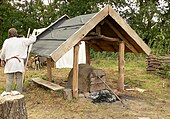RAUZWI - Lively Archeology Middle Weser
| RAUZWI - Lively Archeology Middle Weser | |
|---|---|
| purpose | Promotion of archeology |
| Chair: | Gundula Tessendorff (1st chairman) Stefan Mannchen |
| Establishment date: | 2016 |
| Seat : | Plantanenstrasse 7 31582 Nienburg / Weser |
| Website: | rauzwi.de |
RAUZWI - Lebendige Archeologie Mittelweser is an archeology association based in Nienburg / Weser in Lower Saxony . The aim of the registered association is to research archaeological sites in the Central Weser region near Liebenau and Steyerberg and to reconstruct them.
Surname
The term RAUZWI in the club name is based on runic characters that were found in an excavation in a grave from the 5th century on the old Saxon cemetery of Liebenau in the 1970s. The runic inscription was an outstanding discovery because runic finds are rare in northern Germany . The inscription appears as an incision on a silver decorative disc on the fitting of a sword belt and begins with two runes "ra" and other runes that are interpreted as "zwi". From this RAUZWI was read and interpreted as "consecrated to the spear". However, there are reading and interpretation problems in research, so that neither the scratching nor the assumed meaning are clearly clarified.
description

The association was founded in 2016. Excavation helpers were involved in the establishment of the university. In 2015 they participated in a teaching excavation at the University of Göttingen as volunteers as part of the “ehrenWERT” project of the Hanover Monastery Chamber . The excavation was for the Saxon-Carolingian settlement of Liebenau . The excavation was the reason for the association to initiate a multi-year project for settlement research and landscape development in the area of the old Saxon cemetery of Liebenau. The association is carrying out the project in cooperation with the Department of Prehistory and Early History at the University of Göttingen under the scientific direction of the archaeologist Tobias Scholz and in cooperation with the local archeology of the Schaumburg landscape . After 2015, association members took part in further excavations on the former settlement area. They took place in 2017, 2018 and 2019.
The association operates a small open-air museum near Liebenau , which is located next to the site of the Liebenau cemetery in Old Saxony. It consists of reconstructed buildings from the Saxon period, which currently (2019) include a pit house , a post store and an oven. The facility is to be expanded into a complete courtyard facility. In the museum area there are occasional events with handicraft activities and demonstrations by association members in early medieval clothing, which give insights into life back then. This also takes place on the Open Monument Day
Occasionally, the association holds so-called Old Saxony Camps in the Mittelweser region, where old handicrafts and historical finds from the time of the Saxons are presented to the public.
Riding demonstration on the Open Monument Day 2019
Web links
Individual evidence
- ↑ What does RAUZWI mean? at RAUZWI - Lebendige Archeologie Mittelweser
- ↑ The new association "Rauzwi" was founded in: Die Harke on October 7, 2016
- ↑ a b Excavation of a Saxon-Carolingian settlement near Liebenau, LK Nienburg at hobbyausgrabung.de
- ↑ Gerd Lübbers: Medieval settlement near Liebenau, Nienburg district, Lower Saxony at: Circle of Friends for Archeology in Lower Saxony from 2016
- ^ Settlement research and landscape development in Liebenau at the University of Göttingen
- ↑ 2015 excavation, 2017-2019 excavations at RAUZWI - Lebendige Archäologie Mittelweser e. V.
- ↑ Brought out of hibernation in: Die Rarke, May 8, 2018
- ↑ Insight into the early Middle Ages in: The Rake from September 8, 2017
- ↑ Old crafts and historical finds in: Die Rarke from June 12, 2019



